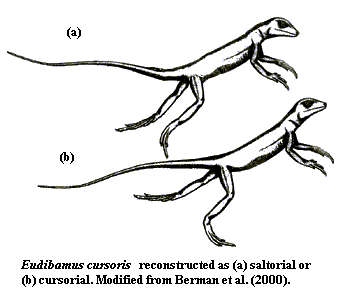Two representations of bolosaurids |
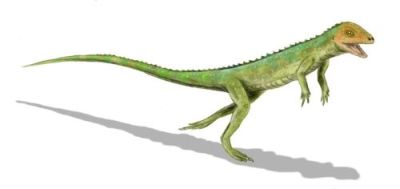 |
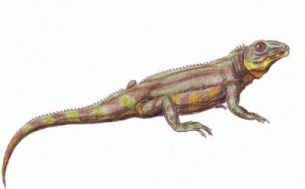 |
As a biped. Life reconstruction of Eudibamus cursoris based on Berman et al. (2000) |
As a quadraped. Life reconstruction of Belebey vegrandis |
The Bolosauridae were one of several lines of distinctive small, lizard-like Permian anapsids. They are also the earliest known anapsids, as far as the current fossil record goes. were widely distributed across Laurasia (low and middle latitude Northern Pangea) during the early and middle Permian but do not seem to have survived the End-Gaudalupian mass-extinction, or extended to the high latitudes. As well as being herbivorous with specialised bulbous teeth, they seem to have been capable of short bursts of bipedal running, although for the most part they would have moved in a sprawling posture. The two illustrations above show the two postures.
There is no reason why both of these explanations may not be correct, nor why either species shown here could not be both faculative bipeds as well as quadrapeds
Early to Middle Permian of Nth Am, Germany, Russia, and China.
Palate without teeth; transverse flange of pterygoid in same plane as palate; dentary and surangular form tall coronoid process; proximal portion of dentary covered by anterior process of prearticular; bulbous, occluding teeth; temporal fenestra long and low, between jugal and squamosal dorsally and quadratojugal ventrally; herbivorous.
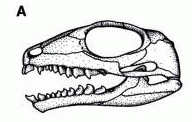 |
skull of B. vegrandis |
B. vegrandis Ivachnenko, 1973 (type species); B. maximi Tverdochlebova, 1987; B. chengi Müller 2008.
Middle Permian of Russia (several species) and China (B. chengi)
Belebey (known from several species, although some of these may be synonymous) and Davletkulia gigantea (known from a single large tooth) were small terrestrial lizard-like animals that seem to have been reasonably common in the Kazanian. It is not known wherther they were faculatively bipedal like Eudibamus. Belebey vegrandis is the best known bolosaur from Eastern Europe. As the name indicates, it is named after the Belebey Svita (formation) where its fossil remains have been found. Similar material has been found in China, indicating the wide distribution of the group.
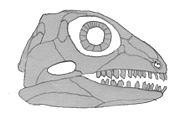 |
Drawing of skull by Ghedoghedo |
E. cursoris Berman, Reisz, Scott, Henrici, Sumida & Martens 2000
Early Permian (Artinskian) of WEur (Tambach Formation, Upper Rotliegend, in the Bromacker quarry locality of the middle part of the Thuringian Forest
Standard total length of about 25 cm
Along with Bolosaurus, this is the oldest known representative of the Anapsida. Both animals appear at about the same time.
Eudibamus cursoris from the Eary Permian of Germany, is the earliest known biped. Berman et al. reconstruct Eudibamus as a cursorial form shown on the image to the right as the illustration (b). The drawing labelled as (a) shows a possible alternate reconstruction as saltorial. Berman et al. reject an arborial clinging & jumping habit because the penultimate phalanges are not elongated as in other organisms with this locomotor style. However, no other cursor or jumper has the primitive tarsal structure of Eudibamus. Accordingly, it may not be entirely safe to rely on such comparisons. Eudibamus has the short neck of a jumping form, although the pelvis is so slight as to make either running or jumping questionable.




